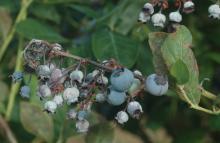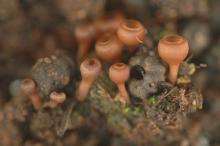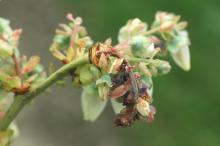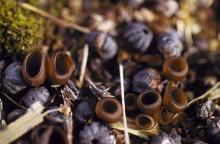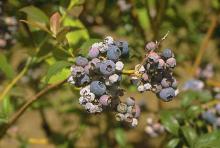See:
Blueberry Cultivar Susceptibility
Cause The fungus Monilinia vaccinii-corymbosi overwinters in mummified fruit (pseudosclerotia) on the ground. Mummies can survive for at least 5 years and maybe more. Often mummified fruit becomes caught near the ground between the stems of a single bush. Mummies have a chilling requirement of many hours below 45°F. In early spring, when the temperature rises above 45°F, about the time floral and vegetative buds begin to break, fungal fruiting cups (apothecia) grow from overwintering mummies in or near the soil surface. Apothecia mature over an average period of 17 days but can range from 8 to 28 days. Many apothecia can emerge from just one mummy. Soil temperature, soil moisture, and solar radiation were identified as the most important factors influencing ascospore release in the PNW.
Ascospores (primary inoculum) from apothecia are wind dispersed 100 feet or more and infect flowers and leaves shortly after buds open. A second type of spore (conidia or secondary inoculum) is produced in about 3 weeks on blighted flowers and shoots. These spores are spread by wind, rain, and various insect pollinators to healthy flowers. Flowers are most susceptible just as they open and infections lead to mummy berry symptoms. Flowers that are already pollinated are less susceptible to infection.
The potential for loss is greater for primary infection because a single infection can blight all the flowers of one cluster. The losses from secondary infection can also be significant but the potential is less because only one berry is lost from each infection.
Infected, sporulating shoots and flowers become ultraviolet reflective, fragrant and secrete sugars making them as attractive to insect pollinators as healthy flowers. Insects then move conidia from these infected shoots and flowers to healthy flowers increasing the number of infected berries.
All species of Vaccinium are infected by species of Monilinia causing a mummy berry-like disease in each. Each species, however, is highly specialized to its host and therefore cannot induce disease in other hosts. For example, the fungal species attacking red huckleberry cannot attack highbush blueberry and vice versa.
The blueberry cultivars Bluetta, and Olympia are considered resistant to both phases of the disease while the cultivars Blueray, Berkeley, Blueribbon, and Earliblue are considered very susceptible.
Symptoms Infected flowers turn brown and wither, as if they had been frosted. Stems and shoots turn dark-brown with the necrosis extending into leaf petioles and slightly into the base of leaf blades along the midrib. The symptoms on leaves have been described as having an oak leaf pattern. Shoots quickly collapse and die soon after. About 3 weeks after primary infection, a brownish gray mass of spores develops on blighted flower stalks and leaves.
During early berry development, diseased fruits look like healthy ones; if cut open, however, the spongy white fungal growth can be seen within the carpels. As berries approach maturity, infected berries become a reddish buff or tan color in contrast to the waxy green of healthy fruits. Many of the diseased berries fall before healthy berries are harvested. Mature mummified berries are gray, shriveled, and hard.
Apothecia can be found under bushes where leaf debris or mulch has been left undisturbed. In spring, before bloom mummies germinate with the emergence of a fungal stipe. Stipes are black at first but become dark to light brown as they elongate. The tip of the stipe then differentiates becoming slightly swollen and darker. The tip of the stipe eventually expands into a cup-shaped structure (apothecium) 0.1 to 0.4 inch wide.
Cultural control Control tactics applied to the soil may need to be repeated often since apothecia develop and mature over a period of several weeks.
- In fall, before leaf drop, shallowly cultivate to bury mummies. Research in Georgia indicates that burying mummies 1 inch or more below the soil prevented apothecia from reaching the surface.
- A two-inch layer of Douglas-fir sawdust applied anytime in the dormant season helps reduce apothecial emergence in the spring.
- In early spring between budbreak and bloom, destroy developing apothecia by disrupting the soil under plants and/or in alleyways by raking or cultivating soil. Some growers cultivate to pile soil from between the rows at the base of the bushes and between the bushes in order to bury the mummies. They rake soil back into the rows later in spring after apothecia are gone. Other growers drag chains or stiff blueberry stems along the ground to disrupt the developing apothecia. Flaming may also be useful.
- Harvest and destroy mummified fruit from bushes before they drop to the ground. This practice may take several years before a benefit can be realized.
- Remove and destroy plant debris that builds up on harvester machines before moving to a new field.
- In spring, destroy any cull piles near packing houses.
- Plant resistant cultivars. Select matching, cross-pollinizing cultivars with synchronized bloom periods so pollination can occur quickly.
- Remove susceptible cultivars such as Berkeley from mixed plantings.
- Good weed control aids cultural measures.
Organic control Control of mummy berry is difficult using organic tactics. Sulfur or copper-based materials have not resulted in effective protection of new flowers and shoots. Organic growers should then focus on reduction of overwintering inoculum. Scouting and aggressive removal of even the smallest amount of mummy berry during and after harvest can be effective in new plantings that do not yet exhibit much disease. Growers with small acreage should focus on removal of as many mummies as possible at and after harvest combined with aggressive disruption of developing apothecia in the spring. Efforts need to be 99.9% effective to have significant impact on this disease.
Chemical control
- Laboratory application of the herbicides diuron or simazine resulted in reduced development and sporulation of apothecia. These herbicides may be beneficial if used close to apothecia development in the spring. Consult the PNW Weed Management Handbook for specific recommendations.
- Rex Lime Sulfur at 8 gal/100 gal water directed to the soil surface during dormancy or after harvest to destroy apothecia. Overall effectiveness is questionable as apothecia have been observed to survive application with viable ascospores. 48-hr reentry. O
- Protect blossoms and foliage with fungicide from floral bud break to end of flowering. From a farm-wide perspective, start when the earliest cultivars break bud. With regular scouting, the first application can be timed to coincide with apothecial development. Tank-mix and/or alternate products from different groups with different modes of action to prevent the build-up of resistant fungi. FRAC 3 fungicides have a high risk of resistance development.
- Abound at 6 to 15.5 fl oz/A. Do not apply with silicone-based surfactants. May be applied on the day of harvest. Group 11 fungicide. 4-hr reentry.
- Bonide Captan 50 WP at 1 to 2 Tbsp/gal water can be used in home gardens - Washington only. H
- Captan 80 WDG at 1.25 to 3 lb/A plus spreader-sticker can only be used starting at mid bloom but may be applied up to day of harvest. Moderate control of both primary and secondary stages. Avoid use when honey bees are active due to larval toxicity. Group M4 fungicide. 48-hr reentry.
- CaptEvate 68 WDG at 4.7 lb/A Can be used day of
harvest. Avoid use when honey bees are active due to larval toxicity. Group 17 + M4 fungicide. 48-hr reentry. - Cevya at 3 to 5 fl oz/A. May be used day of harvest. Group 3 fungicide. 12-hr reentry.
- EcoSwing at 1.5 to 2 pt/A. Can be used day of harvest. Group BM01 fungicide. 4-hr reentry. O
- Fontelis at 24 fl oz/A. Do not use with an adjuvant after petal fall. Can be used day of harvest. Group 7 fungicide. 12-hr reentry.
- Indar 2F at 6 fl oz/A plus a wetting agent. Make reapplication on shortest interval allowed on the label. Do not use within 30 days of harvest. Group 3 fungicide. 12-hr reentry.
- Inspire Super at 16 to 20 fl oz/A. Do not apply within 7 days of harvest. Group 3 + 9 fungicide. 12-hr reentry.
- Kenja 400 SC at 13.5 to 15.5 fl oz/A. Do not apply within 7 days of harvest. Group 7 fungicide. 12-hr reentry.
- Luna Tranquility at 13.6 to 27 fl oz/A. May be used day of harvest. Group 7 + 9 fungicide. 12-hr reentry.
- Miravis Prime at 9 to 13.4 fl oz/A. May be used day of harvest. Group 7 + 12 fungicide. 12-hr reentry.
- Oso SC at 6.5 to 13 fl oz/A. May be applied on the day of harvest. Group 19 fungicide. 4-hr reentry. O
- Pristine at 18.5 to 23 oz/A. Do not use with any other tank additive except Captan. Can be used day of harvest. Group 7 + 11 fungicide. 12-hr reentry.
- Proline 480 SC at 5.7 fl oz/A. Use up to two (2) applications with one targeting the first open blossom. Do not use within 7 days of harvest. Excellent control. Group 3 fungicide. 12-hr reentry.
- Propiconazole-based fungicides are registered. Do not use within 30 days of harvest. Use of propiconazole for mummy berry control has been associated with an increase in Botrytis severity. Do not mix with insecticides during bloom due to honey bee adult and/or larval toxicity. Group 3 fungicides.
- Bumper 41.8 EC at 6 fl oz/A. 12-hr reentry.
- PropiMax EC at 6 fl oz/A. 12-hr reentry.
- Tilt at 6 fl oz/A. 24-hr reentry.
- Propulse at 10 to 13.6 fl oz/A. Do not use within 7 days of harvest. Group 3 + 7 fungicide. 12-hr reentry.
- Quadris at 6 to 15.5 fl oz/A. Do not apply with silicone-based surfactants. May be applied on the day of harvest. Group 11 fungicide. 4-hr reentry.
- Quadris Top at 12 to 14 fl oz/A. Do not apply within 7 days of harvest. Do not mix with insecticides during bloom due to honey bee toxicity. Group 3 + 11 fungicide. 12-hr reentry.
- Quash at 2.5 oz/A. Particularly useful when used just before bloom. Do not use within 7 days of harvest. Excellent control. Group 3 fungicide. 12-hr reentry.
- QuiltXcel at 14 to 21 fl oz/A. Do not use within 30 days of harvest. Sprayers should not be used on apples. Group 3 + 11 fungicide. 12-hr reentry.
- Regalia at 1 to 4 quarts/A plus another fungicide. Use on 7-day intervals. May be used day of harvest. Late bloom applications of high rates may russet fruit. Does not benefit from the addition of an adjuvant. Group P5 fungicide. 4-hr reentry. O
- Regev at 4 to 8.5 fl oz/A. Do not apply within 2 days of harvest. Group 3 + BM01 fungicides. 12-hr reentry.
- Switch 62.5 WG at 11 to 14 oz/A. In western Oregon in 2004, it was not effective on any stage of the disease. May be used up to and including the day of harvest. Group 9 + 12 fungicide. 12-hr reentry.
- Vacciplant at 14 to 22 fl oz/A plus an effective fungicide. Can be used day of harvest. Unknown efficacy in the PNW. Group P4 fungicide. 4-hr reentry.
- Ziram 76 DF at 3 lb/A. Do not apply after 3 weeks from full bloom. Poor control of both primary and secondary stages. Avoid use when honey bees are active due to larval toxicity. Group M3 fungicide. 48-hr reentry.
Note: Some registered products offer only suppression of this disease and thus are not recommended for use. These products include Bravo Weather Stik, Double Nickel 55 (Triathlon BA), Echo and Serenade OPTI.
Protexio is registered but is not being sold due to the garlic-like odor it leaves on fruit.
Forecasting Several systems have been studied and developed in different geographical areas but are not easily used in other regions with different blueberry species. Mummy maturation is influenced partly by hours of cold temperatures in the dormant season where in highbush blueberry a chilling requirement of approximately 700 h below 7°C was needed in Washington but at least 1,500 h in Michigan while rabbiteye blueberry needed 400 to 800 h in Georgia but lowbush blueberry required 800 to 3000 h in Maine. A preliminary model was developed to predict apothecial development for highbush blueberry in the PNW but it has not been validated. A forecasting program was developed in Nova Scotia, Canada on lowbush blueberry for ascospore infection. The program uses leaf wetness and temperature during the wetness period to predict infection. For example, a low risk of infection occurs with 6 hours of wetness at 43°F or 50°F. Use in western Oregon has found that just about every rainy period during apothecial sporulation is identified as an infection period.
Biological control Combine with cultural tactics and/or integrate with synthetic fungicides for best effectiveness.
- Actinovate AG (Streptomyces lydicus strain WYEC 108) at 3 to 12 oz/A plus a spreader-sticker. Do not mix with Regalia or certain copper- or sulfur-based products. Highest rate was moderately effective in western Oregon. Has been effective only on the primary phase of this disease so use before bloom and when temperature is above 45°F. 4-hr reentry. O
- AmyloShield (Bacillus amyloliquefaciens strain PTA-4838) at 1.5 to 3.5 lb/A. Unknown efficacy. Group BM02 fungicide. 12-hr reentry. O
- Aviv (Bacillus subtilis strain IAB/BS03) at 10 to 30 fl oz/100 gal water. Unknown efficacy. Pre-harvest interval not specified. 4-hr reentry. O
- Botector (Aureobasidium pullulans strains DSM 14940 and 14941) at 5 to 10 oz/A depending on water volume. Can be applied day of harvest. Was effective in one western Oregon test at low disease pressure but not in another at high pressure. 4-hr reentry. O
- BotryStop (Urocladium oudemansii U3 strain) at 2 to 4 lb/A. Keep refrigerated before use. Compatible with many wetting agents, some fungicides and biologicals but not all. Unknown efficacy in the PNW. 4-hr reentry. O
- LifeGard WG (Bacillus mycoides isolate J) at 4.5 oz/100 gal water. Label indicates to be used in rotation with fungicides. Does not have direct activity on pathogens but stimulates host defenses. Can be used day of harvest. Did poorly in one trial in western Oregon but very well in several trials in Michigan. 4-hr reentry. O
- Serenade Garden Disease Control Concentrate at 2 to 4 fl oz/gal water. Although useful in Georgia on rabbiteyes, efficacy in the Pacific Northwest is low to none. H O
- Stargus (Bacillus amyloliquefaciens strain F727) at 1 to 4 quarts/A plus a nonionic surfactant. May be used day of harvest. Unknown efficacy in the PNW. 4-hr reentry. O
- Theia (Bacillus subtilis strain AFS032321) at 1.5 to 5 lb/A. May be applied up to and including the day of harvest. 4-hr reentry. O
References Cucak, M., Harteveld, D. O., Wasko DeVetter, L., Peever, T. L., Moral, R. D. A. and Mattupalli, C. 2022. Development of a Decision Support System for the Management of Mummy Berry Disease in Northwestern Washington. Plants, 11:2043.
Florence, J. and, Pscheidt, J. 2017. Monilinia vaccinii-corymbosi apothecial development associated with mulch depth and timing of application. Plant Disease 101:807-814.


